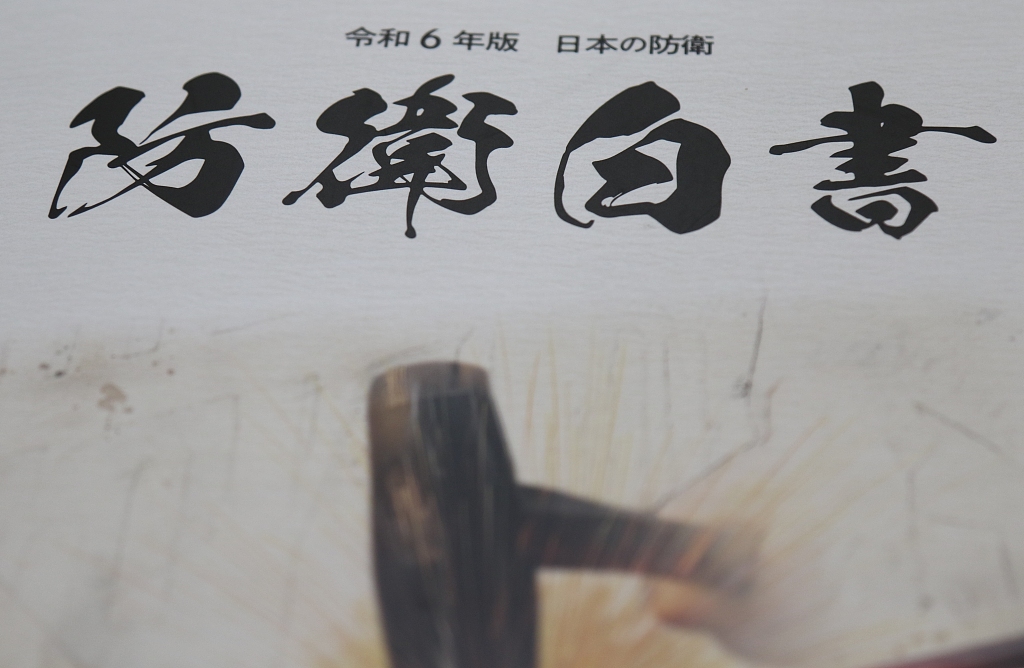
The cover of Japan's latest defense white paper, which was released on Friday, depicts the forging of a samurai sword. This is apt as the document is full of malicious ambitions.
The Japanese side claims that this is intended to show that Japan's defense and deterrence capabilities are being strengthened. But instead it exposes the blade Japan intends to wield with its militarist revival.
READ MORE: Japan overstates 'China threat' in defense paper
China is portrayed as the justification for this. The white paper devotes 30 pages to its claim that China is Japan's biggest strategic challenge, and that China's military activities around Japan are becoming more frequent.
Like the editions in the recent past, the Japanese defense white paper for 2024 is another step backward. A regressive outgrowth of the country's swelling ambitions as it clings to the coattails of the United States "Indo-Pacific" travesty.
It is a further sign of Tokyo's growing impulse to break through Japan's "pacifist Constitution", which gained momentum under the Shinzo Abe Cabinet.
Japan's 2024 defense white paper should worry everyone who wants peace in East Asia. No matter how Tokyo tries to whitewash the country's militarist past and argue the case for its present attempt to rearm itself, a militarily strong Japan unrepentant about past wrongs poses a grave threat to the neighborhood.
The 50th edition of the annual report warrants special attention as it signals that Tokyo is ready to completely cast off the constitutional constraints on rearming Japan.
Every recent Japanese prime minister since Abe has been pushing the envelope to rebuild Japanese military strength. The white paper pushes it further by creating a sense of "crisis" to drag the reluctant Japanese public along with it.
The latest document, presented by the Japanese Ministry of Defense to the National Diet and approved the same day, uses the same pattern Japanese politicians have employed for decades, building its case on imagined, exaggerated threats. But the picture it paints is darker and direr this year.
Its portrayal of an "increasingly aggressive" China, "provocative, nuclear-armed" Democratic People's Republic of Korea and "revanchist" Russia have been familiar tropes of fear in Japan's defense white papers, but this year they are hyped up to imminently menacing proportions.
In the crisis scenario crafted by Tokyo, a "defiant, provocative" Pyongyang is pressing ahead with its missiles and nuclear programs; and if Russia's conflict with Ukraine continues, it will inflict endless woes on the entire world.
"The international community has entered the most trying time of the postwar era," Defense Minister Minoru Kihara claims in his preface to the document."The existing order has been seriously challenged, and we recognize that we are entering a new era of crisis." And, such an era calls for "fundamental reinforcement" of Japanese defense capabilities.
With 30 pages devoted to China, the white paper makes it clear that China is viewed as Japan's foremost "strategic challenge", in the same way the US Defense Department anchors its "Indo-Pacific" security narrative. The two employ almost identical rhetoric: China is escalating tensions in the East and South China seas, in the Taiwan Strait, even intensifying efforts to strengthen coordination with Russia. But most worrying is the seed being planted in the perceptions of the Japanese public that the circumstances are so volatile that the possibility of a "serious situation" occurring in East Asia akin to Russia's conflict with Ukraine, "cannot be ruled out".
ALSO READ: Japan's defense strategy a flawed 'paper plan', say officials
That being said, Tokyo says that there is no other choice for the country but to arm itself to the teeth. So, it has to double its defense spending to 2 percent of GDP and develop and deploy long-range missiles to boost its strike capabilities.
Thus the Japanese authorities' claim that this year's white paper is intended to show how the country is forging a not-to-be-used sword has to be taken with more than a grain of salt.
The blade being forged is not intended to be kept sheathed, as the weapons and technologies and approaches presented in the white paper are all offensive, not defensive.


